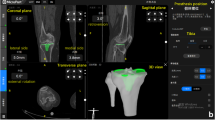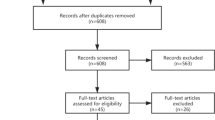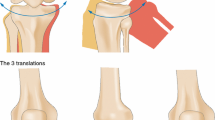Abstract
Purpose
It is now well established that the coronal anatomy of the lower limb is highly variable both in non-arthritic subjects and subjects undergoing total knee arthroplasty (TKA). Two new classifications were recently described independently, but never compared: functional knee phenotypes classification and coronal plane alignment of the knee (CPAK) classification. The hypothesis of this study was that there was a significant difference between the values of the hip–knee–ankle angle (HKA) and the arithmetic hip–knee–ankle angle (aHKA) measures in the same patient at the time of TKA.
Methods
Five hundred and twenty cases were randomly selected among patients operated on for a TKA with navigation assistance. Anatomical parameters were collected during surgery by a navigation system, and the corresponding data of the CPAK classification were calculated. The numerical values of measured HKA and aHKA in the same patient were compared.
Results
The measured HKA had a mean of 3.0° varus (standard deviation of 6.0°). The calculated aHKA had a mean of 1.8° varus (standard deviation 4.8°). There was a significant difference between the values of the two measurements in the same subject (p = 0.005) and a weak negative correlation between the values of the two measurements in the same subject. In addition, there was no relationship between HKA values and joint line obliquity values or CPAK class.
Conclusion
A significant difference and a weak correlation between the values of the HKA and aHKA measures in the same subject were observed. The two analysis techniques used provide different information, and their correlation is only partial. These two techniques therefore appear to be complementary rather than exclusive. The clinical relevance of using these techniques during TKA remains unknown.
Level of evidence
III.






Similar content being viewed by others
Data availability
No data is available.
Abbreviations
- TKA:
-
Total knee arthroplasty
- CPAK:
-
Coronal plane alignment of the knee
- HKA:
-
Mechanical hip–knee–ankle angle
- LDFA:
-
Distal femoral angle measured on the lateral and distal side
- MPTA:
-
Proximal tibial angle measured on the medial and distal side
- aHKA:
-
Arithmetic Hip–Knee–Ankle angle
- JLO:
-
Joint line obliquity
References
Abdel MP, Ollivier M, Parratte S, Trousdale RT, Berry DJ, Pagnano MW (2018) Effect of postoperative mechanical axis alignment on survival and functional outcomes of modern total knee arthroplasties with cement: a concise follow-up at 20 years. J Bone Jt Surg Am 100:472–478
Barbotte F, Delord M, Pujol N (2022) Coronal knee alignment measurements differ on long-standing radiographs vs. by navigation. Orthop Traumatol Surg Res 108:103–112
Beyer F, Pape A, Lützner C, Kirschner S, Lützner J (2021) Similar outcomes in computer-assisted and conventional total knee arthroplasty: ten-year results of a prospective randomized study. BMC Musculoskelet Disord. https://doi.org/10.1186/s12891-021-04556-3
Daxhelet J, Aït-Si-Selmi T, Müller JH, Saffarini M, Ratano S, Bondoux L, Mihov K, Bonnin MP (2021) Custom TKA enables adequate realignment with minimal ligament release and grants satisfactory outcomes in knees that had prior osteotomies or extra-articular fracture sequelae. Knee Surg Sports Traumatol Arthrosc. https://doi.org/10.1007/s00167-021-06619-3
Feichtinger X, Kolbitsch P, Kocijan R, Baierl A, Giurea A (2018) How accurate is intraoperative alignment measurement with a navigation system in primary total knee arthroplasty? J Knee Surg 31:467–471
Hirschmann MT, Moser LB, Amsler F, Behrend H, Leclerq V, Hess S (2019) Functional knee phenotypes: a novel classification for phenotyping the coronal lower limb alignment based on the native alignment in young non-osteoarthritic patients. Knee Surg Sports Traumatol Arthrosc 27:1394–1402
Howell SM (2019) Calipered kinematically aligned total knee arthroplasty: an accurate technique that improves patient outcomes and implant survival. Orthopedics 42:126–135
Hungerford DS, Kenna RV, Krackow KA (1982) The porous-coated anatomic total knee. Orthop Clin N Am 13:103–122
Insall JN, Binazzi R, Soudry M, Mestriner LA (1985) Total knee arthroplasty. Clin Orthop Relat Res 192:13–22
Jenny JY (2010) Coronal plane knee laxity measurement: Is computer-assisted navigation useful? Orthop Traumatol Surg Res 96:583–588
Jenny JY, Baldairon F (2022) The coronal alignment technique impacts deviation from native knee anatomy after total knee arthroplasty. Knee Surg Sports Traumatol Arthrosc. https://doi.org/10.1007/s00167-022-07157-2
Jenny JY, Baldairon F, Hirschmann MT (2022) Functional knee phenotypes of OA patients undergoing total knee arthroplasty are significantly more varus or valgus than in a non-OA control group. Knee Surg Sports Traumatol Arthrosc 30:2609–2616
Jenny JY, Clemens U, Kohler S, Kiefer H, Konermann W, Miehlke RK (2005) Consistency of implantation of a total knee arthroplasty with a non-image-based navigation system: a case-control study of 235 cases compared with 235 conventionally implanted prostheses. J Arthroplasty 20:832–839
McAuliffe MJ, Roe J, Garg G, Whitehouse SL, Crawford R (2017) The varus osteoarthritic knee has no coronal contractures in 90 degrees of flexion. J Knee Surg 30:297–303
McAuliffe MJ, Vakili A, Garg G, Roe J, Whitehouse SL, Crawford R (2017) Are varus knees contracted? Reconciling the literature. J Orthop Surg (Hong Kong) 25:2309499017731445
MacDessi SJ, Griffiths-Jones W, Harris IA, Bellemans J, Chen DB (2021) Coronal plane alignment of the knee (CPAK) classification. Bone Jt J 103-B:329–337
Nam D, Lin KM, Howell SM, Hull ML (2014) Femoral bone and cartilage wear is predictable at 0° and 90° in the osteoarthritic knee treated with total knee arthroplasty. Knee Surg Sports Traumatol Arthrosc 22:2975–2981
Patil S, Bunn A, Bugbee WD, Colwell CW Jr, D’Lima DD (2015) Patient-specific implants with custom cutting blocks better approximate natural knee kinematics than standard TKA without custom cutting blocks. Knee 22:624–629
Rivière C, Iranpour F, Auvinet E, Aframian A, Asare K, Harris S, Cobb J, Parratte S (2017) Mechanical alignment technique for TKA: are there intrinsic technical limitations? Orthop Traumatol Surg Res 103:1057–1067
Ushio T, Mizu-Uchi H, Okazaki K, Miyama K, Akasaki Y, Ma Y, Nakashima Y (2019) Medial soft tissue contracture does not always exist in varus osteoarthritis knees in total knee arthroplasty. Knee Surg Sports Traumatol Arthrosc 27:1642–1650
Funding
No funding was received for this study.
Author information
Authors and Affiliations
Contributions
JYJ conceived the study, analyzed the data and wrote the manuscript. FB collected the data.
Corresponding author
Ethics declarations
Conflict of interest
The authors declare that they have nothing to disclose in relationship with this manuscript.
Ethical approval
This study was conducted after approval by the institutional ethics committee (# CE-2021-32).
Informed consent
Informed consent was obtained from all patients.
Additional information
Publisher's Note
Springer Nature remains neutral with regard to jurisdictional claims in published maps and institutional affiliations.
Rights and permissions
Springer Nature or its licensor (e.g. a society or other partner) holds exclusive rights to this article under a publishing agreement with the author(s) or other rightsholder(s); author self-archiving of the accepted manuscript version of this article is solely governed by the terms of such publishing agreement and applicable law.
About this article
Cite this article
Jenny, JY., Baldairon, F. The coronal plane alignment of the knee classification does not correlate with the functional knee phenotype classification. Knee Surg Sports Traumatol Arthrosc 31, 3906–3911 (2023). https://doi.org/10.1007/s00167-023-07394-z
Received:
Accepted:
Published:
Issue Date:
DOI: https://doi.org/10.1007/s00167-023-07394-z




